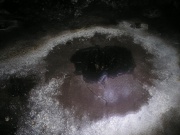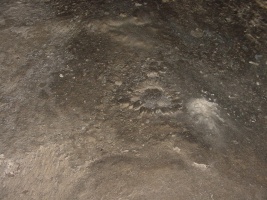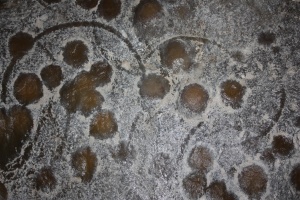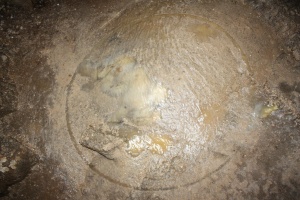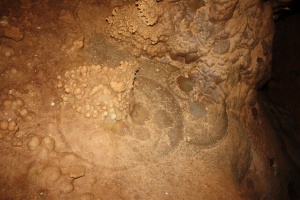Calcite (Inventory)/Splash Ring
From LagWiki
BigRedFoote (Talk | contribs) (Created page with 'File:PJ_SplashRing3.jpg') |
(→Splash Ring, Calcite) |
||
| (14 intermediate revisions not shown) | |||
| Line 1: | Line 1: | ||
| - | [[File:PJ_SplashRing3.jpg| | + | {{Inventory image|File:Splash Ring on Guano.JPG|Splash Ring on [[Vertebrate (Inventory)/Bat Guano|Guano]]. Note the [[Karren (Inventory)/Drip pit, carbonate|drip pit]].}} |
| + | The '''Splash Ring''' field is used to record stations where cave rings appear. | ||
| + | |||
| + | Splash rings (also known as cave rings) are noticeable rings of [[Calcite (Inventory)|calcite]] usually around a central splash point. There are two primary, identified mechanisms for splash ring development. There is no need to note the mechanism on the form; but, it can usually be identified by the diameter of the ring and the presence or absense of a central, hollow [[Calcite (Inventory)/Stalagmite|stalagmite]]. | ||
| + | |||
| + | The first and most common mechanism is when drips of water strike a soft floor surface such as [[Floor (Inventory)/Sediment/Soil|sediment]] or [[Vertebrate (Inventory)/Bat Guano|guano]]. If there is sufficient height, the drips may form a depression and splash outward, depositing their minerals in a circle around the splash point. A central stalagmite may form at the same time. This type of splash ring is almost always between 0.8 and 2 meters in diameter. | ||
| + | |||
| + | The second mechanism is experimentally demonstrated to be when droplets fall and separate into smaller droplets on their way to the floor. This mechanism forms much smaller rings and may not have a central splash point; but, a small mound or stalagmite in the center. | ||
| + | |||
| + | Another, more rare type of splash ring has been observed in the Guads in gypsum. Splash rings can also form when splashes strike hard floor surfaces and wash off softer materials such as sediments or hydromagnesite. | ||
| + | |||
| + | Splash rings are very round when the floor is flat. If the floor has a slope, they will take on an eliptical shape. The ring could be partially obstructed and thus may not form a complete circle. | ||
| + | |||
| + | Look for splash rings on the floor especially when the floor material is soft. | ||
| + | |||
| + | ==See also== | ||
| + | *[[Karren (Inventory)/Drip pit, carbonate|Drip pit, carbonate]] | ||
| + | *[[Karren (Inventory)/Drip pit, gypsum|Drip pit, gypsum]] | ||
| + | |||
| + | ==References== | ||
| + | *Hill, Carol; Paolo Forti (1997) ''Cave Minerals of the World (Second Edition ed.)'' National Speleological Society pp 94-95 ISBN: [[Special:Booksources/1-879961-07-5|1-879961-07-5]] | ||
| + | |||
| + | ==Splash Ring, Calcite== | ||
| + | <gallery perrow=2 widths=300px heights=200px> | ||
| + | File:PJ_SplashRing3.jpg|Splash Ring on Calcite | ||
| + | File:Splash rings.jpg|Overlapping splash rings visible through a thin hydromagnesite layer on flowstone | ||
| + | File:Splash ring.jpg|Splash Ring on flowstone floor by sediment removal | ||
| + | File:Splash rings 2.JPG|Splash rings | ||
| + | </gallery> | ||
| + | |||
| + | {{Cave inventory}} | ||
Current revision as of 01:25, 21 November 2013
The Splash Ring field is used to record stations where cave rings appear.
Splash rings (also known as cave rings) are noticeable rings of calcite usually around a central splash point. There are two primary, identified mechanisms for splash ring development. There is no need to note the mechanism on the form; but, it can usually be identified by the diameter of the ring and the presence or absense of a central, hollow stalagmite.
The first and most common mechanism is when drips of water strike a soft floor surface such as sediment or guano. If there is sufficient height, the drips may form a depression and splash outward, depositing their minerals in a circle around the splash point. A central stalagmite may form at the same time. This type of splash ring is almost always between 0.8 and 2 meters in diameter.
The second mechanism is experimentally demonstrated to be when droplets fall and separate into smaller droplets on their way to the floor. This mechanism forms much smaller rings and may not have a central splash point; but, a small mound or stalagmite in the center.
Another, more rare type of splash ring has been observed in the Guads in gypsum. Splash rings can also form when splashes strike hard floor surfaces and wash off softer materials such as sediments or hydromagnesite.
Splash rings are very round when the floor is flat. If the floor has a slope, they will take on an eliptical shape. The ring could be partially obstructed and thus may not form a complete circle.
Look for splash rings on the floor especially when the floor material is soft.
See also
References
- Hill, Carol; Paolo Forti (1997) Cave Minerals of the World (Second Edition ed.) National Speleological Society pp 94-95 ISBN: 1-879961-07-5
Splash Ring, Calcite
